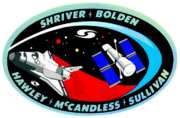STS-31
| Mission emblem | |||
|---|---|---|---|

|
|||
| Mission dates | |||
| Mission: | STS-31 | ||
| COSPAR-ID : | 1990-037A | ||
| Crew: | 5 | ||
| Begin: | April 24, 1990, 12:33:51 UTC | ||
| Starting place: | Kennedy Space Center , LC-39B | ||
| Landing: | April 29, 1990, 13:49:57 UTC | ||
| Landing place: | Edwards Air Force Base , Runway 22 | ||
| Flight duration: | 5d 1h 16m 6s | ||
| Earth orbits: | 80 | ||
| Track height: | 611 km | ||
| Orbit inclination : | 28.45 ° | ||
| Covered track: | 3.3 million km | ||
| Payload: | Hubble | ||
| Team photo | |||
 v. l. No. Charles Bolden, Steven Hawley, Loren Shriver, Bruce McCandless, Kathryn Sullivan |
|||
| ◄ Before / After ► | |||
|
|||
STS-31 ( english S pace T ransportation S ystem ) is a mission designation for the US Space Shuttle Discovery (OV-103) of NASA . The launch took place on April 24, 1990. It was the 35th space shuttle mission and the tenth flight of the space shuttle Discovery. The main task of this mission was to deploy the Hubble space telescope .
The mission was originally planned for October 1986 under the designation STS-61-J with the Atlantis , but was suspended due to the Challenger disaster .
team
- Loren Shriver (2nd space flight), commander
- Charles Bolden (2nd space flight), pilot
- Steven Hawley (3rd spaceflight), mission specialist
- Bruce McCandless (2nd spaceflight), mission specialist
- Kathryn Sullivan (2nd spaceflight), mission specialist
When the crew was set up for a launch in the fall of 1986, John Young was designated as the commander. This was replaced by Loren Shriver.
Mission overview
After various problems, the shuttle launch took place on April 24, 1990 at 8:33:51 a.m. local time in the Kennedy Space Center . The takeoff mass was 112,994 kg. The orbit height of STS-31 was 611 km above the earth's surface, the highest of all shuttle missions. Such an exceptionally high orbit was necessary because the Hubble telescope was to be deployed at this altitude.
The exceptionally high orbit was also used to take special images of the earth with two IMAX cameras (which were the only other payload), which are not feasible at lower orbits. Also z. B. shot the launch of the Hubble telescope with the IMAX cameras. In addition, some scientific experiments took place. The so-called de-orbiting maneuver, in which the shuttle ignites its engines for the last time in order to return to Earth, had the longest duration of all previous de-orbiting maneuvers with a burn time of the engines of four minutes and 58 seconds. This was again due to the high orbit.
The landing took place on April 29, 1990 at 6:49:57 a.m. local time at Edwards Air Force Base . The shuttle took 61 seconds to roll onto the runway and covered 2,705 m. For the first time, carbon brakes were used when a space shuttle landed. The landing mass was 85,783 kg. The Discovery returned to the Kennedy Space Center on May 8, 1990 on the back of a specially converted Boeing 747-100, the Shuttle Carrier Aircraft .
See also
Web links
- NASA Mission overview (English)
- Video summary with comments of the crew (English)
- STS-31 in the Encyclopedia Astronautica (English)

